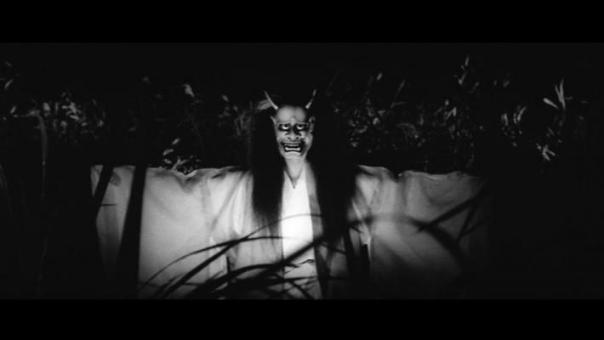Onibaba (1964)
Feudal Japan, jet-black in look and heart, is the setting for this outstanding slice of horror fantasy. Shindo’s film is, at a human level, about the destructive effects of jealousy and lust but also serves as a wider allegory for the corruption of war and the economic system.
The story is something of a fable. The linear narrative concerns two peasants – an old woman and her daughter-in-law- who are forced to murder passing soldiers in order to steal their possessions and trade them for food, as war rages across the country. Men are in scarce supply due to the fighting, so when a returning male neighbour sets out to target the younger woman as a means to satisfy his desires this sets off a chain reaction of green-eyed envy. One could wonder where the horror element enters proceedings, well this comes in the form of a masked Samurai – reportedly maintaining said mask to protect a handsome face – who is quickly despatched by the old woman and falls into a pit holding the skeletons of the couple’s previous victims. The old woman then realises that she can use the Samurai’s mask as a prop to scare her daughter-in-law away from her lecherous suitor.

You know you’re in for something different from the off, as the opening scenes establish our two peasants as unscrupulous and efficient murderesses in a well-choreographed dialogue-less sequence. Their art of murder runs like clockwork, indicating a solid track record in the killing and pillaging of returning Samurai.
There’s lots of shots of nature here; close-up takes of reeds dancing in the wind and of clouds rolling in the sky. Just as stunning are the quick edits of emotion-etched faces and burning eyes darting around the claustrophobic interiors of the small dwellings. The masterful black-and-white photography and exotic visuals alone would be sufficient for a gushing review – and it’s incontestably the images of the mask set against the velvet night which stays with you on the first viewing – but the sound design is a lesson in the utilisation of effects to maximum degree. The whispering reeds, rhythmic (and at times, passion-filled) breathing and dread-inducing score are huge positives. What might surprise a modern audience is the gratuitous display of female nudity and coupled with the presentation of sweaty bodies in sinful embrace, makes for a wave of carnal instinct definitively choked with sexual tension that still stands up today. You can really feel the salacity of the characters in a way which is unusual for films of this period.
The curse of the demon mask itself emerges as quite terrifying in the film’s climatic scenes, punishing both the Samurai and the old woman for their sins. In the Samurai’s case, his sin is presumably that of narcissism whilst the old woman realises only too late that she is being punished for her envy and deception. This final sequence in which the old woman, now panic-stricken, desperately tries to remove the mask from her face is agonising to watch. That said, the horror in ONIBABA is not primarily of a supernatural origin. There’s more brutal fear to be evoked from the inward-looking motivations of human beings, in the extreme circumstances of a situation in which physical possessions are worth far more than life itself.
The reach of ONIBABA has evidently been great, influencing the visual depiction of the demonic face in Friedkin’s THE EXORCIST (1973) and also the symbolic well in 1998’s J-horror classic RINGU.
If there’s a problem with Shindo’s film, it’s most likely in the pacing with the running time being around 15 minutes too long. But that’s of course tolerable when the quality of filmmaking is as high as this. All in all, a simply gargantuan movie in horror cinema and one to be savoured. Indeed, this is in all honesty one of the best films I have seen in years.
Hotdog rating : an easy 10/10
Posted on March 25, 2017, in Uncategorized. Bookmark the permalink. Leave a comment.
Leave a comment
Comments 0